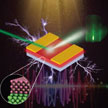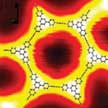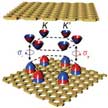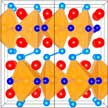Showing Spotlights 617 - 624 of 2879 in category All (newest first):
 New work provides insight into the control over phase and ordering during halide perovskite epitaxial growth and expands the selection of photoactive materials for growing epitaxial halide perovskites that can be exploited in high-performance electronic applications. Hybrid organic-inorganic halide perovskite has attracted tremendous attention as an exceptional new class of semiconductors for solar harvesting, light emission, lasing and thin-film electronics. However, the toxicity of lead devices and lead manufacturing combined with the instability of organic components have been two key barriers to widespread application. Tin-based inorganic halide perovskites have been considered promising substitutes for their lead analogues.
New work provides insight into the control over phase and ordering during halide perovskite epitaxial growth and expands the selection of photoactive materials for growing epitaxial halide perovskites that can be exploited in high-performance electronic applications. Hybrid organic-inorganic halide perovskite has attracted tremendous attention as an exceptional new class of semiconductors for solar harvesting, light emission, lasing and thin-film electronics. However, the toxicity of lead devices and lead manufacturing combined with the instability of organic components have been two key barriers to widespread application. Tin-based inorganic halide perovskites have been considered promising substitutes for their lead analogues.
Nov 7th, 2019
 As an advanced fabrication technique, 3D printing has been increasingly utilized to fabricate complex 3D objects via digitally controlled deposition of phase change and reactive materials and solvent-based inks. When it comes to batteries, 3D printing has several significant advantages compared with conventional battery fabrication technologies and it opens new avenues for the rapid fabrication of 3D-structured batteries with complex architectures and high performance. In next generation futuristic 3D printed energy architectures batteries and supercapacitors could be printed in virtually any shape.
As an advanced fabrication technique, 3D printing has been increasingly utilized to fabricate complex 3D objects via digitally controlled deposition of phase change and reactive materials and solvent-based inks. When it comes to batteries, 3D printing has several significant advantages compared with conventional battery fabrication technologies and it opens new avenues for the rapid fabrication of 3D-structured batteries with complex architectures and high performance. In next generation futuristic 3D printed energy architectures batteries and supercapacitors could be printed in virtually any shape.
Nov 4th, 2019
 Graphyne is a little known sibling of graphene. Simulations have shown that graphyne's conduction electrons travel extremely fast - as they do in graphene - but in only one direction. That property could help researchers design faster transistors and other electronic components that process one-way current. Graphyne is distinct in being composed of sp and sp2 carbon atoms, which contrasts with graphene containing only sp2 carbon. The coexistence of sp and sp2 carbons in graphyne gives rise to unique physical properties, such as high conductivity and large carrier mobility.
Graphyne is a little known sibling of graphene. Simulations have shown that graphyne's conduction electrons travel extremely fast - as they do in graphene - but in only one direction. That property could help researchers design faster transistors and other electronic components that process one-way current. Graphyne is distinct in being composed of sp and sp2 carbon atoms, which contrasts with graphene containing only sp2 carbon. The coexistence of sp and sp2 carbons in graphyne gives rise to unique physical properties, such as high conductivity and large carrier mobility.
Oct 31st, 2019
 The basic idea of valleytronics is to pass information through two-dimensional (2D) and other very thin conducting materials using the energy valleys - or energy extrema - in their conduction and valence bands. Information can be transmitted by controlling an electron's association with a valley - a manipulation that can be achieved using electric fields, magnetic fields and circularly polarized light. Researchers now have demonstrated a room-temperature approach to manipulating quantum-information carriers, which is usually volatile at room temperature, in a monolayer WSe2 semiconductor.
The basic idea of valleytronics is to pass information through two-dimensional (2D) and other very thin conducting materials using the energy valleys - or energy extrema - in their conduction and valence bands. Information can be transmitted by controlling an electron's association with a valley - a manipulation that can be achieved using electric fields, magnetic fields and circularly polarized light. Researchers now have demonstrated a room-temperature approach to manipulating quantum-information carriers, which is usually volatile at room temperature, in a monolayer WSe2 semiconductor.
Oct 24th, 2019
 Hierarchical structures, spanning multiple length scales from nano- to macroscales, are very common in nature; but only in recent years have they been systematically studied in materials science, in order to understand the specific effects they can have on the mechanical properties of various systems. Researchers have developed a straightforward, cost-efficient, and fast route to fabricate hierarchical porous structures in a 3D printer. With this technique they can process nanoporous materials and fabricate structures from nanometer to centimeter scale.
Hierarchical structures, spanning multiple length scales from nano- to macroscales, are very common in nature; but only in recent years have they been systematically studied in materials science, in order to understand the specific effects they can have on the mechanical properties of various systems. Researchers have developed a straightforward, cost-efficient, and fast route to fabricate hierarchical porous structures in a 3D printer. With this technique they can process nanoporous materials and fabricate structures from nanometer to centimeter scale.
Oct 22nd, 2019
 The increase in production and applications of metal-oxide nanoparticles (MO-NPs) raises concerns for the environment as well as for human health. The terrestrial environment, especially soil, is expected to be the largest repository for environmentally released MO-NPs. Therefore, the accurate determination of environmentally released MO-NPs is imperative to assess the real-time scenario of toxicity to soil biota and the threat to human beings via the food chain.
The increase in production and applications of metal-oxide nanoparticles (MO-NPs) raises concerns for the environment as well as for human health. The terrestrial environment, especially soil, is expected to be the largest repository for environmentally released MO-NPs. Therefore, the accurate determination of environmentally released MO-NPs is imperative to assess the real-time scenario of toxicity to soil biota and the threat to human beings via the food chain.
Oct 21st, 2019
 Scientists found that size-confinement - going from macroscopic bulk samples towards nanoparticles - leads to drastic changes in the atomic structure of certain magnetocaloric materials: The change from positive thermal expansion at the macroscale towards a negative thermal expansion (NTE) at the nanoscale. NTE materials are of increasing technological interest mostly because of the idea of mixing them with a symmetric negative thermal expansion material in order to create a composite material which has near-zero thermal expansion. The nanoparticle shape is particularly suitable for the design of such composites.
Scientists found that size-confinement - going from macroscopic bulk samples towards nanoparticles - leads to drastic changes in the atomic structure of certain magnetocaloric materials: The change from positive thermal expansion at the macroscale towards a negative thermal expansion (NTE) at the nanoscale. NTE materials are of increasing technological interest mostly because of the idea of mixing them with a symmetric negative thermal expansion material in order to create a composite material which has near-zero thermal expansion. The nanoparticle shape is particularly suitable for the design of such composites.
Oct 10th, 2019
 2019 marks the 150th anniversary of the Periodic Table, a unique tool, enabling scientist to predict the appearance and properties of matter on the Earth and in the the Universe. Different elements have played critical roles in different periods of human activities, with silicon (Si) being a key element, at present. However, the nanotechnology age has brought different elements into the limelight and transformed their roles in science and technology. A recent article discusses the most relevant elements from a nanotechnology perspective and their applications in nanomaterials.
2019 marks the 150th anniversary of the Periodic Table, a unique tool, enabling scientist to predict the appearance and properties of matter on the Earth and in the the Universe. Different elements have played critical roles in different periods of human activities, with silicon (Si) being a key element, at present. However, the nanotechnology age has brought different elements into the limelight and transformed their roles in science and technology. A recent article discusses the most relevant elements from a nanotechnology perspective and their applications in nanomaterials.
Oct 9th, 2019
 New work provides insight into the control over phase and ordering during halide perovskite epitaxial growth and expands the selection of photoactive materials for growing epitaxial halide perovskites that can be exploited in high-performance electronic applications. Hybrid organic-inorganic halide perovskite has attracted tremendous attention as an exceptional new class of semiconductors for solar harvesting, light emission, lasing and thin-film electronics. However, the toxicity of lead devices and lead manufacturing combined with the instability of organic components have been two key barriers to widespread application. Tin-based inorganic halide perovskites have been considered promising substitutes for their lead analogues.
New work provides insight into the control over phase and ordering during halide perovskite epitaxial growth and expands the selection of photoactive materials for growing epitaxial halide perovskites that can be exploited in high-performance electronic applications. Hybrid organic-inorganic halide perovskite has attracted tremendous attention as an exceptional new class of semiconductors for solar harvesting, light emission, lasing and thin-film electronics. However, the toxicity of lead devices and lead manufacturing combined with the instability of organic components have been two key barriers to widespread application. Tin-based inorganic halide perovskites have been considered promising substitutes for their lead analogues. 
 Subscribe to our Nanotechnology Spotlight feed
Subscribe to our Nanotechnology Spotlight feed





